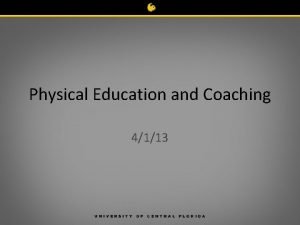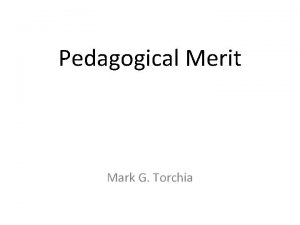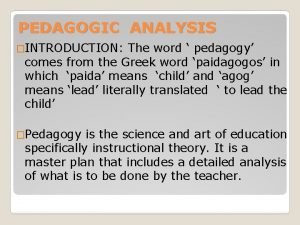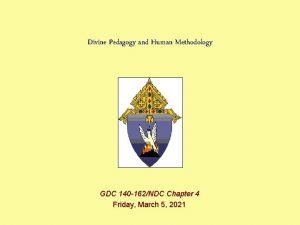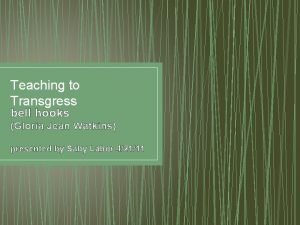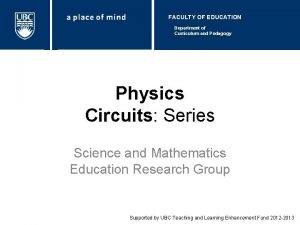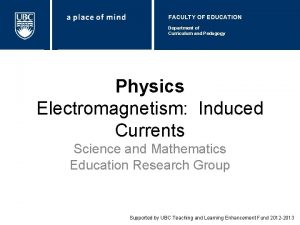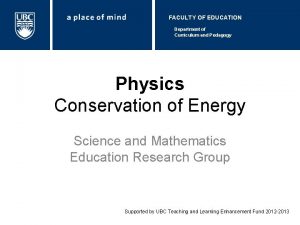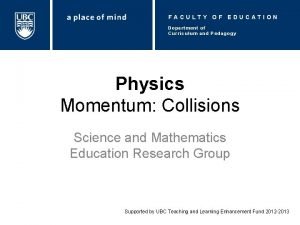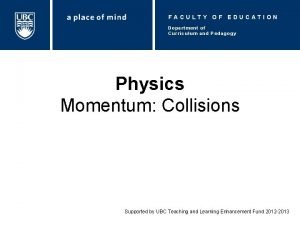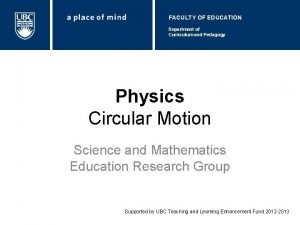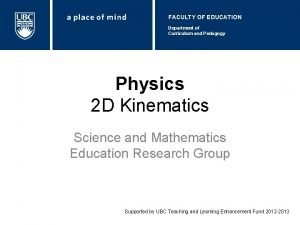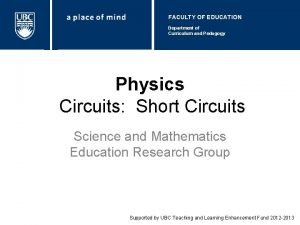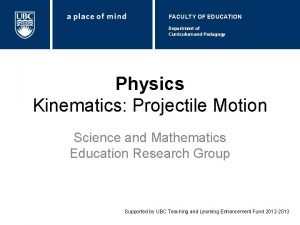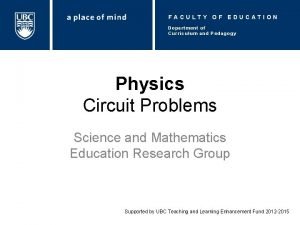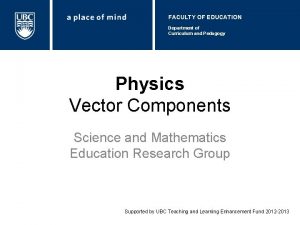FACULTY OF EDUCATION Department of Curriculum and Pedagogy



























- Slides: 27

FACULTY OF EDUCATION Department of Curriculum and Pedagogy Physical Science Astronomy: Phases of the Moon 2 Science and Mathematics Education Research Group Supported by UBC Teaching and Learning Enhancement Fund 2012 -2014

Phases of the Moon (Part 2) Comments

Phases of Title the Moon I Question What percentage of the Moon’s surface is illuminated at 1: 00 pm, 3: 00 am, and 12: 00 am, respectively? A. 50%, 50% B. 0%, 50%, 0% C. 0%, 30%, 0% D. 100%, 100%

Solution Comments Answer: A Justification: Fifty percent of the Moon’s surface is illuminated by the Sun’s light at all times, regardless of how much of the illuminated side is visible to us. Remember that the Moon’s orbit is on an incline from the Ecliptic Plane. Therefore, the Earth rarely blocks any of the direct sunlight destined for the Moon. Even during a Lunar and Solar eclipse, fifty percent of the Moon remains illuminated.

Extend Your Learning: Comments Thought Experiment What about a Lunar eclipse? How does light reach the Moon if the Moon is supposedly in the Earth’s shadow? Although the Earth’s shadow does block all of the direct sunlight from reaching the Moon, some light is bent through Earth’s atmosphere and does manage to reach the Moon’s surface. By the same process that creates the beautiful reds and oranges characteristic of sunsets, the light that reaches the Moon during the lunar eclipse is red shifted.

GIF Phases of Title the Moon II Question What is responsible for the phases of the Moon? A. The Earth’s shadow is cast on a portion of the Moon B. The Moon spins between its dark and light sides C. The Sun moves behind a portion of the Moon D. The Moon moves behind a portion of the Sun E. None of the above

Solution Comments Answer: E Justification: In questions II, III, and IV in the first set on phases we determined that the phases of the Moon (or the “ball” in the questions) are the result of observing the illuminated half of the Moon from different angles. When the entire illuminated side is visible from your angle, you observe a full-moon. When half the illuminated side is visible form your angle, you see a half-moon.

Extend Your Learning: Video Comments Title: Bill Nye – Phases of the Moon

Phases of The Moon Comments Simulation This simulation will help you to understand the ideas in the following questions. If, at any point, you are confused about the concepts – return to this slide to try out the simulation.

Phases of Title the Moon III Question Which night sky corresponds to the horizon seen by the observer in the following diagram? A C B D

Solution Comments Answer: C Justification: Nearly the entire illuminated side of the moon is visible to the observer.

Phases of Title the Moon IV Question Which night sky corresponds to the horizon seen by the observer in the following diagram? A B C D

Solution Comments Answer: B Justification: Nearly the half of the illuminated side of the moon is visible to the observer. Therefore, the observer only sees the rightmost side of the half of the sphere that is facing the Earth, because the left side of the sphere has no sunlight reflecting from it.

Phases of Title the Moon V Question Which night sky corresponds to the horizon seen by the observer in the following diagram? A B C D

Solution Comments Answer: C Justification: The Moon moves slowly enough that we can consider it to be stationary. This means that when we see the Moon and Sun each day, it is due to the rotation of the Earth. As a person standing on Earth, it is possible for you to see 180º range of motion. Another way to think about this is to imagine that there is a line going through the middle of the Earth (yellow line), with you standing at along a line that is at a 90º (red line). If the Moon falls outside of this 180º, it is not observable by you. Therefore, here you see no Moon in the night sky.

Phases of Title the Moon VI Question If an observer sees the following night sky, which diagram correctly depicts the position of the moon and observer? A B C D

Solution Comments Answer: C Justification: The Moon’s position is almost over head and only half of the illuminated side of the Moon is visible from the location of the observer.

Extend Your Learning: Video Comments Title: Phases of the Earth (from Moon)

Phases of Title the Moon VII Question How often do we experience a moonless night? B A A. Once a month B. Twice a month C C. Every Lunar Eclipse D D. Every Solar Eclipse

Solution Title Question Answer: A Justification: We experience a moonless night once a month when the moon is closest to the sun. Moonless nights occur when the Moon is in between the Earth and the Sun, so that the Moon is entirely unobservable from the half of the globe experiencing night time. A C B D

Phases of Title the Moon VIII Question The Canadian Government is planning on building an observatory so that high school students can study the Moon better. They want to build the telescope in a location that maximizes the number of hours that the students can observe the Moon. In which location. Bshould they A construct the observatory? A. South Pole B. C North Pole D C. Equator D. All locations are equal

Solution Title Question Answer: D Justification: The observatory can be constructed in any of the B locations, as the Moon will be observable for the same amount of A time each day from any longitude on the Earths surface. As long as the observer is on the side of the Earth that faces the Moon, they will be able to see the moon for the same amount of time regardless of longitude. C D

Phases of Title the Moon IX Question How many hours is the Moon observable from a single location on the Earth’s surface over the course of one day? (Assume you have a telescope. ) A B A. 12 hrs B. 6 hrs C. Depends on the phase of the Moon C D

Solution Title Question Answer: A Justification: Remember this diagram from a previous question. A person on Earth is capable of seeing a range of 180º (yellow line), with the person standing perpendicular to this line (red line). One rotation of the Earth is a total of 360º and takes approximately 24 hours to complete. Also remember that the Moon moves so slowly that we can consider it to be stationary. Therefore our only concern is how long it takes the C D Earth to make one complete rotation. Knowing that a person on Earth is only capable of seeing 180º, which is one half of a rotation, we can determine that a person can see the Moon for one half of a rotation. 360º / 2 = 180º 24 / 2 = 12 hours

Phases of Title the Moon X Question Can you ever see the moon in the sky during the day? A B A. Yes B. No C D

Solution Title Question Answer: Yes Justification: The Moon and the Sun can be seen at the same time during the day. In fact, for fifty percent of the time the Moon A is in the sky during the day time. However, because the Moon is not nearly as bright as the Sun, the Moon is not always noticeable to the naked eye. C D

Extend Your Learning: Comments Lunar Quizzer
 Education scotland play pedagogy toolkit
Education scotland play pedagogy toolkit Gauteng department of education strategic plan 2020
Gauteng department of education strategic plan 2020 Nit calicut chemistry
Nit calicut chemistry Ga tapp program
Ga tapp program Sport pedagogy definition
Sport pedagogy definition Advanced pedagogy and application of ict
Advanced pedagogy and application of ict Epistemology and pedagogy
Epistemology and pedagogy Importance of faculty in higher education
Importance of faculty in higher education Myfile york
Myfile york Faculty of education
Faculty of education Uvu professor salary
Uvu professor salary Faculty of education khon kaen university
Faculty of education khon kaen university Techno-pedagogy
Techno-pedagogy Public pedagogy definition
Public pedagogy definition Pedagogical vs andragogical
Pedagogical vs andragogical Peda meaning in pedagogy
Peda meaning in pedagogy Example of equity pedagogy
Example of equity pedagogy What is gender responsive pedagogy
What is gender responsive pedagogy Maria__090915
Maria__090915 Pronounce pedagogical
Pronounce pedagogical Need and importance of pedagogical analysis
Need and importance of pedagogical analysis Gradual release of responsibility pedagogy
Gradual release of responsibility pedagogy Paradigm shift from pedagogy to andragogy to heutagogy ppt
Paradigm shift from pedagogy to andragogy to heutagogy ppt Divine pedagogy
Divine pedagogy A pedagogy of multiliteracies designing social futures
A pedagogy of multiliteracies designing social futures Humanizing pedagogy
Humanizing pedagogy Bottom up approach reading
Bottom up approach reading Gloria jean watkins
Gloria jean watkins
